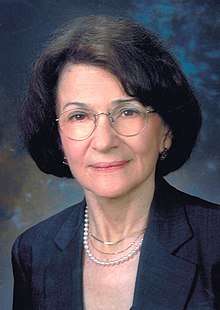Patricia Goldman-Rakic
Patricia Goldman-Rakic (/rəˈkiːʃ/ rə-KEESH; née Shoer, April 22, 1937 – July 31, 2003) was an American professor of neuroscience, neurology, psychiatry and psychology at Yale University School of Medicine.[1] She pioneered multidisciplinary research of the prefrontal cortex and working memory.[2]
Patricia Goldman-Rakic (née Shoer) | |
|---|---|
 | |
| Born | April 22, 1937 Salem, Massachusetts, United States |
| Died | July 31, 2003 Hamden, Connecticut, United States |
| Nationality | United States |
| Alma mater | Vassar, UCLA |
| Awards | List
Source: Yale News:[1] |
| Scientific career | |
| Fields | neurobiology |
| Institutions | Yale University |
| Doctoral advisor | Wendell Jeffrey |
Early life and education
Patricia Shoer was born in Salem, Massachusetts.[3] Her father, Irving Shoer, was the son of Latvian immigrants and her mother, Jenny Pearl, was a Russian immigrant. She grew up in Peabody, Massachusetts and attended Peabody High School.[4] Goldman-Rakic earned her bachelor's degree cum laude in neurobiology from Vassar in 1959, and her doctorate from the University of California at Los Angeles in Developmental Psychology in 1963.[5][6]
After postdoctoral positions at UCLA and New York University, Goldman-Rakic worked at the National Institute of Mental Health in neuropsychology and later as Chief of Developmental Neurobiology.[5] She moved to Yale School of Medicine in 1979 where she remained until her death. She was The Eugene Higgins Professor of Neuroscience in the neurobiology department with joint appointments in the departments of psychiatry, neurology, and psychology.[7][8][9]
Research
Goldman-Rakic was the first to discover and describe the circuitry of the prefrontal cortex and its relationship to working memory. Previously, scientists thought that the higher cognitive functions of the prefrontal cortex were beyond the scope of scientific study. Goldman-Rakic's research showed that methods employed to study the sensory cortices could be adapted to the highest order prefrontal cortical areas, revealing the circuit basis for higher cognitive function.[10] Because of Goldman-Rakic, scientists began to better understand the neurobiological basis of higher cognitive function, and of such disorders as schizophrenia, Alzheimer's, Attention deficit hyperactivity disorder (ADHD), cerebral palsy, Parkinson's disease, and dementia. She used a multidisciplinary approach, applying biochemical, electrophysiological, pharmacological, anatomical and behavioral techniques to study working memory.[1] She pioneered the first studies of dopamine influences on prefrontal cortical function, research that is critical to our understanding of schizophrenia, ADHD and Parkinson's disease. A review of her life's work, including her special role mentoring women scientists, can be found in the journal Neuron.[11]
Goldman-Rakic co-authored over 300 scholarly articles and co-edited 3 books.[4] She was the founder of the Cerebral Cortex Journal, a specialized publication by Oxford Press. Early in her career, she studied the capacity of the brain to repair itself in early development, and was one of the first to use radioactive tracers to examine this phenomenon.[12]
Personal life
Goldman-Rakic had two sisters, one her identical twin. She was married to Pasko Rakic, also a neuroscientist.
Death
On July 29, 2003, Goldman-Rakic was struck by a car while crossing a street in Hamden, Connecticut. She died two days later, on July 31 at Yale-New Haven Hospital.[7] She is buried in Grove Street Cemetery.[1]
After her tragic death, Constance and Stephen Lieber created the Goldman-Rakic Prize for Outstanding Achievement in Cognitive Neuroscience to celebrate her memory and her discoveries about the brain's frontal lobe. This prize is awarded every year to outstanding scientists, from psychiatrist to molecular neuroscientist, for their impact in the study of cognition. The prize carries an award of $40,000 and the winner(s) is honored at the annual International Awards Dinner in New York City.[13]
Honors and awards
- National Institute of Mental Health grantee (1980–2000)
- W. Alden spencer Award, Columbia University (1982)
- Krieg Cortical Discoverer Award, Cajal Club (1989)
- Inducted National Academy of Sciences (1990)
- Fyssen Foundation Prize in Neuroscience (1990)
- Lieber Prize, National Alliance for Research on Schizophrenia and Depression (1991)
- Inducted American Academy of Arts and Sciences (1991)
- Robert J. and Claire Pasarow Foundation Medical Research Award (1993)
- Karl Lashley Award, American Philosophical Society (1996)
- Ariëns Kappers Medal, Royal Netherlands Academy of Arts and Sciences (1996)
- Honorary doctorate, Utrecht University (2000)
- Gerard Prize, Society for Neuroscience (2002)
Goldman-Rakic was also the President of the Society for Neuroscience from 1989-1990 and a fellow of The American Psychological Association.[1]
References
- "In Memoriam: Patricia Goldman-Rakic, Preeminent Yale Neuroscientist who Made Groundbreaking Discoveries in Working Memory and Explored the Brain's Frontal Lobe". Yale News. August 1, 2003. Retrieved 12 November 2013.
- "Renowned neuroscientist Patricia Goldman-Rakic dies". Yale Bulletin and Calendar. 32 (1). August 29, 2003. Archived from the original on June 16, 2013. Retrieved November 12, 2013.
- McFadden, Robert D. (2003-08-04). "Patricia S. Goldman-Rakic, Neuroscientist, Dies at 66". The New York Times. Retrieved March 3, 2019.
- "Patricia Goldman-Rakic". Retrieved March 3, 2019.
- "Patricia Goldman-Rakic", Newsmakers, Issue 4. Gale Group, 2002. Reproduced in Biography Resource Center. Farmington Hills, Mich.: Thomson Gale. 2007. http://galenet.galegroup.com/servlet/BioRC
- Fuster, Joaquín M (2003). "Patricia Goldman-Rakic 1937–2003". Nature Neuroscience. 6 (10): 1015. doi:10.1038/nn1003-1015.
- Dawson, M (2003). "Patricia Goldman-Rakic dies: Sudden death of multidisciplinary trailblazer in frontal lobe studies shocks the world of neuroscience".
- Arnsten, A. F. T (2013). "The Neurobiology of Thought: The Groundbreaking Discoveries of Patricia Goldman-Rakic 1937-2003". Cerebral Cortex. 23 (10): 2269–81. doi:10.1093/cercor/bht195. PMC 3767966. PMID 23926115.
- Aghajanian, George; Bunney, Benjamin S; Holzman, Philip S (2003). "Patricia Goldman-Rakic, 1937–2003". Neuropsychopharmacology. 28 (12): 2218. doi:10.1038/sj.npp.1300325.
- Goldman-Rakic PS (1995). "Cellular basis of working memory". Neuron. 14 (3): 447–485. doi:10.1016/0896-6273(95)90304-6. PMID 7695894.
- Arnsten Af (2003). "Patricia Goldman-Rakic: A Remembrance". Neuron. 40 (3): 465–70. doi:10.1016/s0896-6273(03)00685-8.
- Aghajanian, George; Bunney, Benjamin; Holzman, Philip (2003). "Patricia Goldman-Rakic, 1937–2003". Neuropsychopharmacology. 28 (12): 2218. doi:10.1038/sj.npp.1300325.
- https://www.bbrfoundation.org/grants-prizes/prizes-awards/goldman-rakic-prize-outstanding-achievement-cognitive-neuroscience